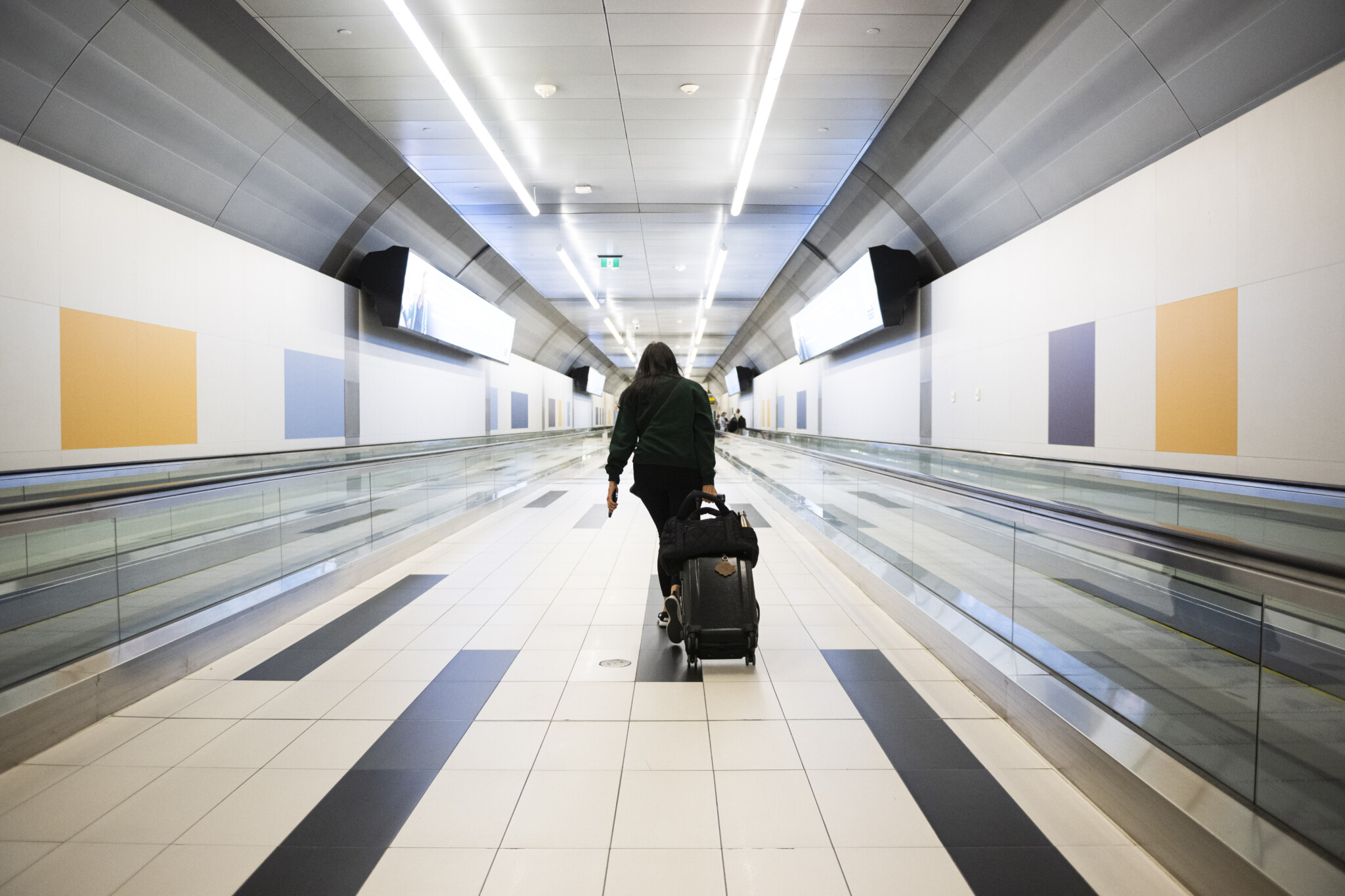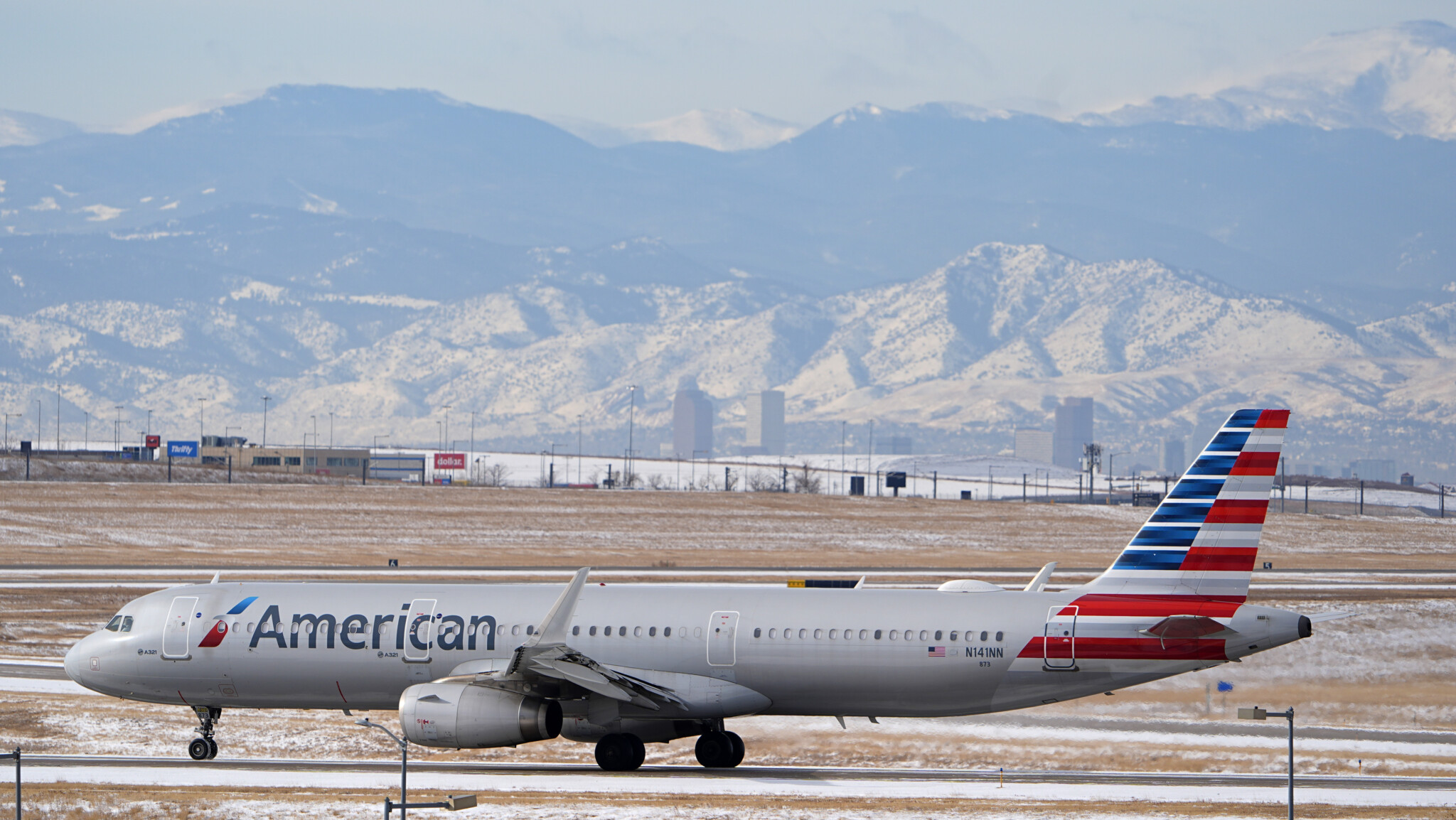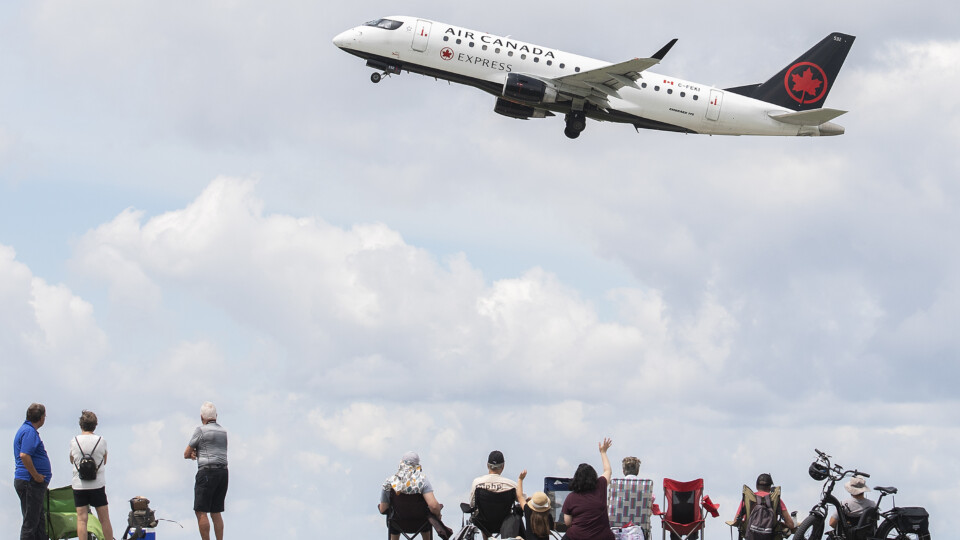DeepDives is a bi-weekly essay series exploring key issues related to the economy. The goal of the series is to provide Hub readers with original analysis of the economic trends and ideas that are shaping this high-stakes moment for Canadian productivity, prosperity, and economic well-being. The series features the writing of leading academics, area experts, and policy practitioners. The DeepDives series is made possible thanks to the ongoing support of Centre for Civic Engagement.
Canada’s airline market makes Canadians groan because of high fares and high costs. Many Canadians simply cross the border to take flights at far smaller (with fewer landside services) airports to get lower prices. The savings these Canadians obtain give us an idea of how much cheaper things could be. For the same destinations, crossing the border can save a traveller roughly 30 percent on fares—even with the extra cost of crossing the border by car and parking at one of the American airports. These higher costs are despite a half-hearted but generally successful set of reforms that started in the 1980s.
The reason for the groans is simple: over-regulation and over-involvement of the federal government. It is time to put an end to this and engage in a major deregulatory and privatization effort to produce reductions in airfares and increases in the competitiveness of the airline market.
With a new federal government likely on the horizon and affordability being an important issue in the eyes of voters, pursuing the policy reforms of ending cabotage restrictions, removing foreign ownership limits, and even privatizing airports could bring much-needed competition to the airline industry while lowering prices for Canadians.
The rise and small fall of government over-involvement in airlines
In 1903, the federal government placed transportation regulatory powers in the hands of the Board of Railway Commissioners. With the rise of air transport, the Board’s name was changed to Board of Transport Commissioners (now known as Canadian Transportation Agency) in 1937 with the ability to also regulate air transport. From then on, federal regulation gradually tightened with changes to legislation and enforcement powers.
Starting in 1937, the Crown corporation Trans-Canada Airlines (later renamed Air Canada) held an exclusive monopoly over all domestic transcontinental and international routes. This monopoly’s reach was slightly reduced in 1948 when Canadian Pacific was designated as the international carrier for the Pacific region. Additional exceptions were made for a few provincial airlines, notably Quebecair, which operated smaller routes within the provinces. By 1974, 91 percent of market share was for Air Canada and Canadian Pacific. Entry was controlled through a strict licensing system based on largely subjective (and thus interpretable with discretion for regulators) criteria such as “necessity and convenience.” Routes had to be approved by the regulatory agency in charge while rates and fares were also regulated. Finally, airports were not a private matter—rather they were virtually always the property of the federal government.
The system was highly rigid, with no indication of falling prices, even though planes frequently departed well below passenger capacity. Such outcomes prompted growing calls for reforms—which were fueled by the fact that Americans had begun deregulating airline markets in 1978. There was a minor easing of regulatory restrictions in the late 1970s, but the big push came in 1984. New carriers were allowed to enter the industry, price regulation was relaxed and greater allowances for offering discounted fares were made. For example, airlines were allowed to offer discounts of up to 30 percent on economy class without providing advance notice to regulators. By 1989, Air Canada was fully privatized.
This was, as we will see below, a half-hearted deregulation. Nevertheless, it yielded desirable outcomes. Prices fell 10 percent (maybe more) in the four years immediately after deregulation (less than the 15 percent decline observed in the United States), and passenger-kilometres increased by close to 20 percent as new firms entered the market.
Why do I say “half-hearted”? Because significant barriers to competition still exist today, providing incumbent firms with a comfortable, less competitive environment. These barriers include: a) cabotage regulations, b) foreign ownership restrictions, and c) airport ownership. Eliminating all three simultaneously would enable the development of a highly competitive airline market, better integrated within North America, with reduced gate fees and lower airfares.
Cabotage regulation
Canada enforces strict cabotage regulations, which limit foreign carriers, like Delta Airlines or Air France, from transporting passengers between two Canadian cities. For example, if Delta wanted to fly from Vancouver to Toronto and pick up passengers there before continuing to Boston, it currently couldn’t. Delta would need to rely on Air Canada or another Canadian airline to handle the domestic portion of the journey.

People walk through Billy Bishop Airport in Toronto on Friday, July 19, 2024. Christopher Katsarov/The Canadian Press.
Yet, cabotage restrictions are not unique to Canada. In fact, they are very much the norm. Many countries, such as the United States, or groups of countries, such as the European Union (EU), have them. The difference is that Canada, unlike them, is a very small market. In the United States and the European Union, we are talking about hundreds of millions of consumers. For Canada, we are talking a few tens of millions (adding visitors and residents). This means that large economies of scale simply cannot be tapped.
Opening up domestic flights to international carriers would have the effect of allowing firms that are quite large—and thus are on a scale that permits lower costs per mile travelled—to extend their services to Canadians and compete with incumbent firms like Air Canada. Simultaneously, it would also facilitate the entry of new firms—such as low-cost airlines—that specialize in servicing a few key destinations. Overall, there would be far more competition than there is now.
We know the price-reducing potential of such a reform thanks to the European Union. In the 1990s, the EU began permitting cabotage among its member countries, thus creating a market of 400 million consumers (larger than the United States). While cabotage restrictions still apply to non-members, this policy effectively expanded the market size within the union. In other words, Air France could bring people from Munich to Madrid without breaking the law. The result is that new airlines—especially low-cost airlines—have entered the market and developed ways to push down fares massively. These low-cost airlines (such as Ryanair) began servicing smaller markets in order to connect them to prized destinations (e.g., going from Birmingham to London and then to Ibiza). Within five years of this liberalization, prices had fallen for 90 percent to 95 percent of consumers.
Conferring cabotage rights to foreign carriers could easily replicate these benefits. However, the key challenge is avoiding “selective” rights. By “selective,” I mean those selected by regulators and politicians. Selective rights grant regulators the power and discretion to decide who operates, when, where, and how often. This creates the risk of regulatory capture, a well-known concept in economics that proposes that close interactions between regulators and the regulated foster a symbiotic relationship, ultimately reducing competition and allowing government to serve the interests of industry. Hence, the idea of “capture.”
An example of selectiveness would be to allow what is known as consecutive cabotage, where passengers are brought, for example, from Edmonton to Montreal and then to Paris by Air France. However, Air France would not be allowed to bring passengers simply from Edmonton to Montreal without them also buying the Paris leg of the trip. This would create carveouts for incumbent firms, which would further restrict competition.
The proper approach is one of “shock” therapy—the total elimination of all cabotage prohibitions except when they clearly clash with national security considerations (and these would have to be defined on objective criteria rather than subjective ones). No gradualism, no incrementalism, just a straight-up overnight opening of the market. The ultimate structure of the market will be hard to predict, but the one guarantee we have is that there will be far fewer barriers to entry (which means more contestable markets and thus more market-based discipline on carriers), a larger number of providers, a larger number of service points and, most importantly, lower fares.
Foreign ownership restrictions
The effects of cabotage restrictions are complemented by restriction of foreign ownership. Under the Canada Transportation Act, foreign ownership of Canadian airlines is limited to 49 percent, with no individual non-Canadian able to control more than 25 percent.
These restrictions have two effects. First, they make it difficult for firms to raise capital outside of Canadian markets. In a highly capital-intensive industry, limiting access to foreign investors reduces the industry’s competitiveness by restricting its ability to secure the funds needed to adopt new technologies and techniques that could lower costs in the long run.
Importantly, the Canadian government has explicitly acknowledged this issue in the past. Historically, these foreign ownership restrictions were even tighter, with international ownership capped at just 25 percent, compared to the current limit of 49 percent. This was significantly more restrictive than in the United States, where foreign investors can own up to 49.9 percent of an airline’s stock, although voting shares are capped at 25 percent. In 2018, the Transportation Modernization Act was adopted by the Trudeau government, which raised the cap to 49 percent (what it is today). In the minister’s press release following the royal assent of the act, the government stated that “raising international ownership limits means that Canadian air carriers, including all-cargo services, have access to more investment capital.”
Second, it hinders the entry of new firms into the market, reinforcing the same goals that cabotage restrictions pursue—limiting competition and protecting domestic industries from foreign competitors. By restricting foreign ownership, these policies create significant barriers for potential new entrants, both domestic and foreign, making it harder for them to establish a foothold in the Canadian market. Without foreign ownership restrictions, a foreign air carrier could potentially enter the Canadian market by establishing a Canadian-incorporated firm, where all the shareholders are non-Canadians. Although the company would be domestically incorporated, it would be able to operate in the Canadian market and coordinate with another foreign-owned company, effectively creating a legal distinction without any real economic difference. This would allow foreign firms to sidestep the intent of cabotage laws entirely. In this scenario, the cabotage restrictions would be significantly weakened, although still somewhat bothersome, but no longer a major barrier to market entry or competition. In other words, cabotage restrictions are damaging competition and that is complemented and secured by the foreign ownership restrictions.
Again, the federal government admitted as much. In the same press release as mentioned above, the federal government stated clearly that it expected the raising of the limit to “bring more competition into the Canadian air sector, more choice for Canadians, greater connectivity in underserved regions, and benefits for airports and suppliers, including the creation of new jobs.”

An American Airlines jetliner rumbles down a runway for take off from Denver International Airport, Jan. 16, 2024, in Denver. David Zalubowski/AP Photo.
Eliminating all foreign ownership restrictions would heighten the effects of removing the cabotage regulations. First, it would allow Canadian firms to invite foreign capital to scale up their activities. Second, it would allow Canadian firms to more easily set up alliances (in alliance, airlines share resources, extend partner routes, and allow earning and redeeming miles across each other’s reward program) with foreign firms and thus coordinate better with other markets. Both of these would complement the pro-competition effect of granting cabotage rights as it would allow airlines to compete on increasing service quantity and quality through greater investments.
Airport ownership
In 1992, the federal government introduced a peculiar form of airport “privatization” that differed from typical models seen in other countries. Normally, privatization involves the government selling assets through a competitive bidding process, with private firms acquiring ownership. However, in this case, the federal government retained ownership and only privatized the management and operations of airports. Even here, the term “privatized” is misleading, as the private firms operate under a 60-year emphyteutic lease, paying rent to the federal government. Adding to the misfit of the term “privatized,” the private operators must be non-profit entities, meaning any excess revenue must be reinvested into the airports. As a result, any increase in the value of these investments ultimately benefits the federal government, not the operators.
This system has a series of important downsides. The first is that the federal government has no incentives to increase the number of airports it owns or ease regulations that would allow non-federal airports to increase their services. More airports—given the rent formula created by the federal government—mean smaller rents if traffic is redirected to other airports. And these rents are substantial. In 2013, federally owned but privately operated airports paid $294 million in rent to the federal government. In 2022-23, it was $419 million. These numbers represent roughly 11 percent to 12 percent of the total revenues of the largest airports.
The second downside is a byproduct of the first. Airlines pay landing and gate fees to airports, and if airports were allowed to expand their operations or if new airports were opened, these fees would likely decrease due to increased supply. However, under the current system, expanding airport capacity is prohibitively difficult or simply not a priority for the federal government, limiting the potential for reducing landing and gate fees. This easily explains why the airport fees charged to airlines are far higher than those in the United States. For example, Toronto’s Pearson International Airport frequently dominates the rankings of landing fees. Today, a Boeing 777-300 at Pearson would pay landing fees of $4,157 USD or roughly $10 per passenger if it is at full capacity. That number increases with every additional minute spent at the gate and with the fewer passengers that board. This is compared to a fee of $1,632 USD for the same plane at Paris Charles de Gaulle.
This may look small, but it must be added to the third downside. To meet the operating conditions set by the federal government and compensate for the funds diverted to rent payments, airports impose a range of “airport improvement fees” (AIF) directly on consumers when they purchase tickets. For instance, at Toronto Pearson International Airport, the fee is $35 per departing passenger and $7 per connecting passenger. This is the seventh-highest of 82 airports in Canada. While these fees may seem small, they significantly increase the overall cost of air travel. They explain roughly 25 percent of the price difference in airfares between the U.S. and Canada. As a result, many Canadians choose to cross the border to fly out of smaller U.S. airports (e.g., Plattsburg, Burlington, Bellingham), which actively market to Canadians seeking to avoid these extra charges (not only the AIF but also sales taxes, security fees, gasoline taxes, and the NAV Canada surcharge). Estimates for 2011 suggest that the number of travelers who decided to head to American airports represented between 19 percent and 21 percent of the volume at airports such as Montreal, Vancouver, and Toronto.
The fourth downside is a by-product of all the others. Due to higher airport improvement fees, which reduce demand, and higher landing fees, which raise operating costs and reduce supply, non-incumbent firms are discouraged from entering the Canadian market, even in cases where cabotage regulations don’t apply (e.g. when servicing routes between a Canadian city and a non-Canadian city without in-Canada connections). This further insulates incumbent players from competition. The insulation is so strong that low-cost U.S. airlines often choose to set up operations in border airports, incurring the fixed costs of new facilities rather than using existing gates at Canadian airports. This highlights the extent of protection provided to incumbent firms.
Combined, these are major downsides. To fully create a competitive airline market, the Canadian government needs to do what it should have done in 1992: privatize the airports outright. Simultaneously, a regulatory review should be enacted to see which components of the regulations prevent non-federal airports from scaling up their activities or even from being built. Only genuine safety-related regulations (meeting cost-benefits analysis standards) should be kept.
This is an absolutely necessary complement to the abolition of cabotage restrictions and the removal of foreign ownership restrictions in order to create a competitive airline market in Canada. In fact, the Emerson report (which has essentially been shelved) called it a necessary ingredient to make Canada’s airlines more competitive.
Key takeaways
Canada’s airline market has become far more competitive since the days of government monopolization and heavy regulation between the 1930s and 1970s. However, there are still many miles to cover before we reach the destination of a truly open and competitive airline industry. Yet, that final stop promises lower airfares, higher quality, and more opportunities for Canadians to take to the skies. The three-pronged approach of abolishing cabotage restrictions, loosening foreign ownership restrictions, and privatizing airports is the best place to get us to that destination.




